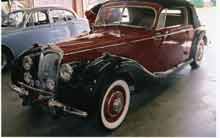I remember distinctly my first meeting with a Riley. It was an RMD drophead coupe like this one, and it belonged to cartoonist Robert Osborn, a friend of my parents. The
illustrator of, inter alia, John Keats’ 1958 book
The Insolent Chariots, which excoriated the excesses of 1950s Detroit, Osborn might seem an unlikely Riley owner. He bought the car, however, perhaps on impulse, from a New York Times classified around 1959, and drove it for the rest of his nine-decade life.
Don Irving’s
Riley RMD is just like Osborn’s, only it’s been fully restored. The RM-series Rileys are my favorites, because they combine traditional British lines with an emergent streamlining, in the way of that other under-appreciated car, the MG TF. Round and rectangular gauges in a
varnished wood dashboard remind one of an old Atwater Kent radio. Ugly sister of the RMD was the RMC roadster, a three-seater car with an enormous, ungainly trunk. Intended to appeal to Americans, it found its best market in Australia, and even that was disappointing.
Victor Riley of Coventry was a bicycle manufacturer turned automaker, which enabled him to describe his automobiles “As Old as the Industry; As Modern as the Hour.” Intially they looked like bicycles, but by the 1930s Rileys were among the most stylish of cars, the Kestrel sedans
of 1934-38 being a case in point. Alongside the RMC and RMD open cars, Riley built both 1.5-liter and 2.5-liter saloons, the RMA/RME amd RMB/RMF series, respectively. Don also has an
RMF, which, when I saw it, was
completing restoration. The
Riley engine is sometimes mistakenly described as double overhead cam. It has two camshafts, but they are located high in the block and work the valves with short pushrods.
The last “real Riley” is usually considered the 1953-57 Pathfinder, which, although it shares a body with the Wolseley 6/90, has a real Riley engine. Victor Riley was not a good businessman, and his company was absorbed into the Nuffield Organisation (William Morris’s empire) in 1938. Morris, of course, joined with Austin to form the British Motor Corporation in 1952, and Riley cars could not escape becoming badge-egineered corporate clones. The One Point Five of 1957-65 was a Morris Oxford/Wolseley knock-off, and a larger, six-cylinder 2.6 borrowed the MG ZA Magnette body shell, a la Wolseley 6/90. With the finned “Farina” body shell of 1959 came the Riley 4/68, later (with a larger, 1,622 cc version of the
BMC “B” series engine) the 4/72. The
4/72 continued in production until the Riley badge was retired in 1969; while not an exciting car it did retain a
wooden dash, albeit with all round instruments. Perhaps the rarest Riley is the
Riviera, a modified 4/72 created by Wessex Motors of Salisbury, Wiltshire. Dressed up with wire wheels and bonnett-mounted driving lights, the Riviera had subtly-bobbed tail fins. Amazingly, this exact car survives. Almost comic among the recent Rileys were the
Elf, an upmarket Mini, and the revived Kestrel, a version of the 1100 and 1300 BMC siblings.
If you crave more information about Rileys, there’s plenty on Rob’s Riley Page. I’ll leave the last word about Riley to Robert Osborn. In his 1982
autobiography he wrote that his RMD had lines that “only a capable artist could have devised.”

